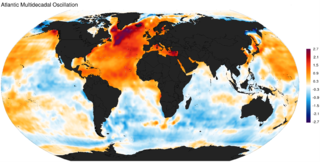Related Research Articles

The Geophysical Fluid Dynamics Laboratory (GFDL) is a laboratory in the National Oceanic and Atmospheric Administration (NOAA) Office of Oceanic and Atmospheric Research (OAR). The current director is Venkatachalam Ramaswamy. It is one of seven Research Laboratories within NOAA's OAR.
The North Equatorial Current (NEC) is a westward wind-driven current mostly located near the equator, but the location varies from different oceans. The NEC in the Pacific and the Atlantic is about 5°-20°N, while the NEC in the Indian Ocean is very close to the equator. It ranges from the sea surface down to 400 m in the western Pacific.

The Atlantic meridional overturning circulation (AMOC) is part of a global thermohaline circulation in the oceans and is the zonally integrated component of surface and deep currents in the Atlantic Ocean. It is characterized by a northward flow of warm, salty water in the upper layers of the Atlantic, and a southward flow of colder, deep waters. These "limbs" are linked by regions of overturning in the Nordic and Labrador Seas and the Southern Ocean, although the extent of overturning in the Labrador Sea is disputed. The AMOC is an important component of the Earth's climate system, and is a result of both atmospheric and thermohaline drivers.

Joseph Smagorinsky was an American meteorologist and the first director of the National Oceanic and Atmospheric Administration (NOAA)'s Geophysical Fluid Dynamics Laboratory (GFDL).

Earth's climate system is a complex system with five interacting components: the atmosphere (air), the hydrosphere (water), the cryosphere, the lithosphere and the biosphere. Climate is the statistical characterization of the climate system, representing the average weather, typically over a period of 30 years, and is determined by a combination of processes in the climate system, such as ocean currents and wind patterns. Circulation in the atmosphere and oceans is primarily driven by solar radiation and transports heat from the tropical regions to regions that receive less energy from the Sun. The water cycle also moves energy throughout the climate system. In addition, different chemical elements, necessary for life, are constantly recycled between the different components.

Syukuro "Suki" Manabe is a Japanese–American meteorologist and climatologist who pioneered the use of computers to simulate global climate change and natural climate variations. He was awarded the 2021 Nobel Prize in Physics jointly with Klaus Hasselmann and Giorgio Parisi, for his contributions to the physical modeling of earth's climate, quantifying its variability, and predictions of climate change.

The Atlantic Multidecadal Oscillation (AMO), also known as Atlantic Multidecadal Variability (AMV), is the theorized variability of the sea surface temperature (SST) of the North Atlantic Ocean on the timescale of several decades.
Geophysical Fluid Dynamics Laboratory Coupled Model is a coupled atmosphere–ocean general circulation model (AOGCM) developed at the NOAA Geophysical Fluid Dynamics Laboratory in the United States. It is one of the leading climate models used in the Fourth Assessment Report of the IPCC, along with models developed at the Max Planck Institute for Climate Research, the Hadley Centre and the National Center for Atmospheric Research.

Thomas R. Knutson is a climate modeller at the US Geophysical Fluid Dynamics Laboratory, a division of the National Oceanic and Atmospheric Administration (NOAA). His research covers hurricane activity, the link between climate change and hurricane incidence and intensity, and climate change detection and attribution.
This is a list of climate change topics.

Isaac Meyer Held is an American meteorologist. He is a retired senior research scientist at the Geophysical Fluid Dynamics Laboratory. Held was elected to the United States National Academy of Sciences in 2003.
The Arctic dipole anomaly is a pressure pattern characterized by high pressure on the arctic regions of North America and low pressure on those of Eurasia. This pattern sometimes replaces the Arctic oscillation and the North Atlantic oscillation. It was observed for the first time in the first decade of 2000s and is perhaps linked to recent climate change. The Arctic dipole lets more southern winds into the Arctic Ocean resulting in more ice melting. The summer 2007 event played an important role in the record low sea ice extent which was recorded in September. The Arctic dipole has also been linked to changes in arctic circulation patterns that cause drier winters in Northern Europe, but much wetter winters in Southern Europe and colder winters in East Asia, Europe and the eastern half of North America.
The Tropical Atlantic SST Dipole refers to a cross-equatorial sea surface temperature (SST) pattern that appears dominant on decadal timescales. It has a period of about 12 years, with the SST anomalies manifesting their most pronounced features around 10–15 degrees of latitude off of the Equator. It is also referred to as the interhemispheric SST gradient or the Meridional Atlantic mode.
Explosive volcanic eruptions affect the global climate in several ways.

The cold blob in the North Atlantic describes a cold temperature anomaly of ocean surface waters, affecting the Atlantic Meridional Overturning Circulation (AMOC) which is part of the thermohaline circulation, possibly related to global warming-induced melting of the Greenland ice sheet.

Axel Timmermann is a German climate physicist and oceanographer with an interest in climate dynamics, human migration, dynamical systems' analysis, ice-sheet modeling and sea level. He served a co-author of the IPCC Third Assessment Report and a lead author of IPCC Fifth Assessment Report. His research has been cited over 18,000 times and has an h-index of 70 and i10-index of 161. In 2017, he became a Distinguished Professor at Pusan National University and the founding Director of the Institute for Basic Science Center for Climate Physics. In December 2018, the Center began to utilize a 1.43-petaflop Cray XC50 supercomputer, named Aleph, for climate physics research.
Shian-Jiann Lin is a Taiwanese-American atmospheric scientist. He is currently the head of the Weather and Climate Dynamics Division at the Geophysical Fluid Dynamics Laboratory, the lead developer of the GFDL Finite-Volume Cubed-Sphere Dynamical Core (FV3). and a lead developer or key contributor to several weather and climate models developed using FV3.

Pacific Meridional Mode (PMM) is a climate mode in the North Pacific. In its positive state, it is characterized by the coupling of weaker trade winds in the northeast Pacific Ocean between Hawaii and Baja California with decreased evaporation over the ocean, thus increasing sea surface temperatures (SST); and the reverse during its negative state. This coupling develops during the winter months and spreads southwestward towards the equator and the central and western Pacific during spring, until it reaches the Intertropical Convergence Zone (ITCZ), which tends to shift north in response to a positive PMM.

Thomas L. Delworth is an atmospheric and oceanic climate scientist and Senior Scientist at the Geophysical Fluid Dynamics Laboratory (GFDL), part of NOAA. He also serves on the faculty of Oceanic Science at Princeton University.

Ronald J. Stouffer is a meteorologist and adjunct professor at the University of Arizona, formerly Senior Research Climatologist and head of the Climate and Ecosystems Group at the Geophysical Fluid Dynamics Laboratory (GFDL), part of NOAA. He has also served on the faculty of Princeton University.
References
- 1 2 3 Zhang, Rong. "Rong Zhang Homepage". www.gfdl.noaa.gov. Retrieved 2021-12-28.
- ↑ "Rong Zhang". Welcome to NOAA Research. Retrieved 2021-12-28.
- ↑ "Effects of Variability in Atlantic Ocean Circulation". Eos. 2019-07-09. Retrieved 2021-12-28.
- ↑ "Natural variability could slow the pace of Arctic summer sea ice loss, study says". Carbon Brief. 2015-03-30. Retrieved 2021-12-28.
- 1 2 3 "Northwest Atlantic Ocean may get warmer, sooner: High resolution global climate model shows much faster warming and changing ocean circulation". ScienceDaily. Retrieved 2021-12-28.
- ↑ "Rong Zhang Named AMS Bernhard Haurwitz Memorial Lecturer". Atmospheric & Oceanic Sciences. Retrieved 2021-12-28.